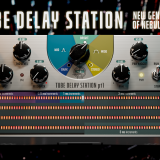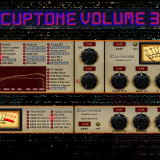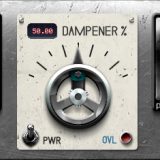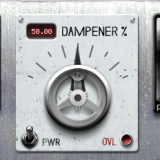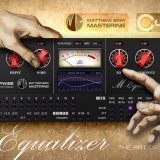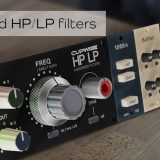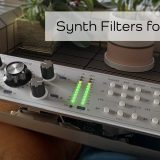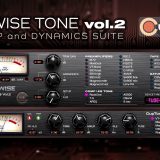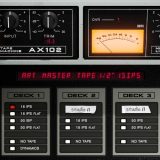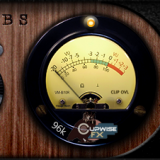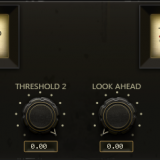Someone asked for some details about how I made the tracks in my album and I thought it would be fun to go over some of the things I think stand out and that I can remember. All of them started as modular jams. The patches weren’t really technical or ‘clever’, just a lot of analog oscillators and filters which have lots of inputs and outputs for audio and CV, and lots of modulation options, which I used extensively. When I first did these jams, about 8-9 years ago, my eurorack setup was mostly modules by a maker called Blue Lantern. He was selling complete systems at a pretty steep discount so that was my entry point into the format.
Blue Lantern modules can be very cool because, at least for those earlier ones I have, he would have a lot more ins and outs for modulations and weird controls that you wouldn’t see on other modules that were using the same circuit as the source for their design. They’re almost like ‘circuit bent’ versions of these common circuits. One of the oscs I used is the Transistor Pyramid Core VCO which has two types of synch, which sound different, exponential and linear FM, which sound different, many output shapes and PWM, and it just sounds great (based on a Buchla design). I had that and another BL osc with similar features, and a lot of the grungier sounds I got on the album, the growly, gurgling bass sequences that also have a lot of higher freq stuff going on, were achieved by cross-modulating those two oscs in various ways.
For most tracks on the album I wasn’t super concerned with having elaborate melodies or sequences, I just used a Blue Lantern arpeggiator module to generate some arpeggios, and I would turn the knobs on that live to get different notes brought into the sequences it made, which I would be using to control the oscs. The oscs would be sent to various Blue Lantern filters which had the same design philosophy as the oscs- built on designs that have been around for decades and used and reused by countless makers, but adding extra features everywhere possible for more sound design capability. This really resonates with me. So a lot of the tracks on the album were based around me just patching these arpeggiated oscs so they are mangling each other, and then going into these filters which were further mangling them, until I got a nice soupy wall of sound.
I would do filter sweeps and other adjustments live. Another key module for at least some of the tracks is the Synthrotek Eko, a very cheap and simple PT2399 based delay. It can do some simple echoes but if you modulate the delay time you can have everything collapse into a black hole and explode again in pure chaos. It’s pretty crazy and fun, and for a few tracks I would ‘rehearse’ a sort of compositional idea where I would use it to collapse everything into chaos at just the right time. In some cases I had the major elements of the track going into it and I would use adjusting the delay time to change the tempo and rhythm of everything.
There were a lot of other modules being used, mostly other BL ones, and I would just keep patching them together, using everything in my rack (maybe 25 modules would be patched in a big spaghetti mess, to make each of these tracks), to create these patterns that could keep going on their own, and sounded pretty nice to me, then I would record myself tweaking knobs live for a few hours. A few years later I began editing out some of the best bits and turning them into tracks. The original recordings were usually MONO mixdowns, and probably driven a bit too hot somewhere in the chain because I wanted a crunchy sound. I also usually avoided having amplitude envelopes on the oscs, opting for a continuous wall of free-running oscillator sound. The end recording obviously was pretty lacking in amplitude dynamics.
When I started editing, I wanted to introduce some dynamics back in to the recordings, but keep the spirit of the jams intact. I used a lot of EQing, with various plugins, including some Acquas, and even some of my own Nebula programs. This brought some of the frequencies out and enhanced some of the rhythmic qualities. I would edit some bits out that went on for too long. I used various methods to introduce some stereo image to the recordings. In most cases what you hear is still basically the modular jams but highly polished up and enhanced. Tracks 1 and 7 are exceptions. For track 1, I took the soupier bassy gurgling part of the track and processed it very heavily with Image Line’s Harmor, which is an image resynthesis plugin. I used it to harmonize the modular gurgles and create the entire ‘chord progression’ that you hear in the track, by using different harmonizer settings for each harmony. I used multiband processing to leave some of the content of the original recording unmolested by Harmor, and just panned it around instead. Multiband processing was heavily used during the editing/mixing, often to pan higher frequencies around or to add other effects only in certain frequency ranges.
Track 7 was created after most of the other tracks and I used a module called the Grendel, which is a vocal formant filter. The original recording was too monotonous so I sliced it into phrases and pitched some of them up and down to bring in some dynamics to the pitch. I did the pitching mostly just by using Reaper’s built-in pitch shifting ability for audio clips. I experimented with the different available pitch shifting algos for each slice, discovering that the nature of the synth recording (being kind of squelchy), really worked well with some of the more lo-fi pitch shifting methods to get really nice gritty sounds. The end of that track was processed with my Sooper Time Tube stereo program.
I did a few overdubs, like the barely audible chords in track 7 that happen in a few places, but especially in track 8. The intro to track 8 was filtered with different filters from my ‘mixing filters 3 hycor’ Nebula filter pack. Before that it was just a constant bassy gurgle but the different filters and applying a fade in made a nice intro. I think this this track goes on maybe a little too long, but it might have my favorite part of the album starting at 7:58 (those background sounds are overdubs). The squeeky sound that echoes in track 10 used my Nolard tape delay programs, various settings for each echo. The part starting at 1:41 in track 2, uses an unreleased program I made from my orban stereo synthesizer (a pseudo stereo comb filter unit). The effect gets more and more intense and I think it makes everything sound like it’s getting bigger and bigger and coming from outside out of the boundaries of the speakers (or headphones).
Track 3 also used Harmor. Each section of the gurgly synth is processed differently with Harmor, then they were processed through my modular again (mainly using a module that clones the Korg PS-3300 filter bank), and I came up with a ‘drum’ overdub, created with a modular patch and sequenced in a way where it seems to be related to the synth patterns, but in a drunken way. Track 4 is the only one that had different elements recorded separately, so I just panned those around to get a stereo mix for that one. Tracks 5 and 6 are the most ‘pure’ in the sense that what you hear is very close to the original recordings, just a little editing for time, EQing, and some of my Nebula reverbs were applied (like with every track), however the intro and outro of track 5 was filtered and processed a lot (ends with a big wash of my BX20 reverb).
Track 10, the last track, is from one of my first ever modular recordings (2014?), and it’s actually two takes of a more planned out composition, edited together. That one used the cheap Eko delay module a lot, but not for echoes, just for texture and rhythmic changes. I really like the bubbly textures I got here, in the first half. The really low pitched bubbly sounds were made by creating a delayed copy of the main bubbly synth recording and pitching it down (and mangling it a bit) with an old spectral FFT plugin called DtBlkFx.
I used many many instances of Nebula, with my own products. Probably every product was used at least once somewhere in the album. My tube radio and cassette programs were used pretty extensively to alter the tones, and my various reverbs were used everywhere too. I used Waves’ F6 dynamic EQ whenever I needed some really surgical EQing (really nice plugin). After the mixes could have been called finished, I decided to record every separate element (everything was recorded to mono originally but now I had many layers I had separated out of the recording in various ways, and some overdubs and effects tracks) to cassette tape and back using my Marantz deck. This is the deck I used to make Cassette Deck 3. I had used my Nebula tape programs but I wanted to go beyond what the programs can do. I recorded every track in each mix, using various tapes (and tape types), in single and double speed mode (this deck can do 2x speed), and redigitized the output. This was done in one pass while monitoring off of the tape, so the deck was being used as an effects loop, and this allowed me to hear exactly what the saturation on each sound sounded like in the context of the rest of the mix.
I think the main benefit of that was just the tape compression. I didn’t really drive the tapes hot enough for distortion usually. But the compression brought the mixes together more than they were previously. Track 9 is one exception where I used various levels of tape distortion towards the end, to make it more dramatic. After everything was ‘tapified’, I did the final mix-down in my more recent modular system, using a really high quality input/output module and several mixer modules. In a few cases I applied some subtle filtering or other processing while doing this. Then I used my and Michael’s M-EQ for mastering, with some subtle C660 compression.
